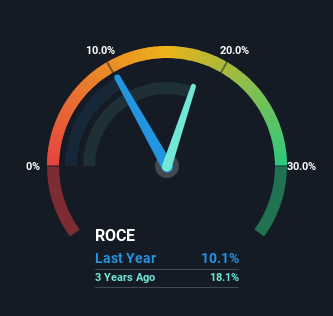There Are Reasons To Feel Uneasy About KRBL's (NSE:KRBL) Returns On Capital

Finding a business that has the potential to grow substantially is not easy, but it is possible if we look at a few key financial metrics. Amongst other things, we'll want to see two things; firstly, a growing return on capital employed (ROCE) and secondly, an expansion in the company's amount of capital employed. Ultimately, this demonstrates that it's a business that is reinvesting profits at increasing rates of return. Having said that, from a first glance at KRBL (NSE:KRBL) we aren't jumping out of our chairs at how returns are trending, but let's have a deeper look.
What Is Return On Capital Employed (ROCE)?
For those who don't know, ROCE is a measure of a company's yearly pre-tax profit (its return), relative to the capital employed in the business. To calculate this metric for KRBL, this is the formula:
Return on Capital Employed = Earnings Before Interest and Tax (EBIT) ÷ (Total Assets - Current Liabilities)
0.10 = ₹5.2b ÷ (₹57b - ₹6.4b) (Based on the trailing twelve months to September 2024).
So, KRBL has an ROCE of 10%. That's a relatively normal return on capital, and it's around the 12% generated by the Food industry.
See our latest analysis for KRBL

Historical performance is a great place to start when researching a stock so above you can see the gauge for KRBL's ROCE against it's prior returns. If you'd like to look at how KRBL has performed in the past in other metrics, you can view this free graph of KRBL's past earnings, revenue and cash flow.
What Does the ROCE Trend For KRBL Tell Us?
When we looked at the ROCE trend at KRBL, we didn't gain much confidence. Around five years ago the returns on capital were 25%, but since then they've fallen to 10%. Meanwhile, the business is utilizing more capital but this hasn't moved the needle much in terms of sales in the past 12 months, so this could reflect longer term investments. It's worth keeping an eye on the company's earnings from here on to see if these investments do end up contributing to the bottom line.
The Bottom Line On KRBL's ROCE
Bringing it all together, while we're somewhat encouraged by KRBL's reinvestment in its own business, we're aware that returns are shrinking. And with the stock having returned a mere 6.1% in the last five years to shareholders, you could argue that they're aware of these lackluster trends. As a result, if you're hunting for a multi-bagger, we think you'd have more luck elsewhere.
KRBL does have some risks though, and we've spotted 2 warning signs for KRBL that you might be interested in.
For those who like to invest in solid companies, check out this free list of companies with solid balance sheets and high returns on equity.
Valuation is complex, but we're here to simplify it.
Discover if KRBL might be undervalued or overvalued with our detailed analysis, featuring fair value estimates, potential risks, dividends, insider trades, and its financial condition.
Access Free AnalysisHave feedback on this article? Concerned about the content? Get in touch with us directly. Alternatively, email editorial-team (at) simplywallst.com.
This article by Simply Wall St is general in nature. We provide commentary based on historical data and analyst forecasts only using an unbiased methodology and our articles are not intended to be financial advice. It does not constitute a recommendation to buy or sell any stock, and does not take account of your objectives, or your financial situation. We aim to bring you long-term focused analysis driven by fundamental data. Note that our analysis may not factor in the latest price-sensitive company announcements or qualitative material. Simply Wall St has no position in any stocks mentioned.
About NSEI:KRBL
KRBL
Manufactures and markets rice products in India and internationally.
Flawless balance sheet second-rate dividend payer.
Similar Companies
Market Insights
Community Narratives



